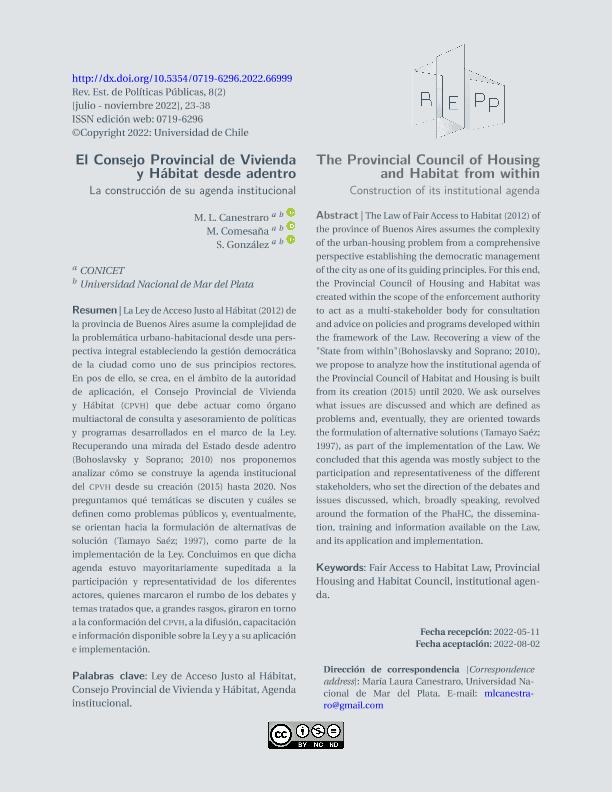Artículo
La Ley de Acceso Justo al Hábitat (2012) de la provincia de Buenos Aires asume la complejidad de la problemática urbano-habitacional desde una perspectiva integral estableciendo la gestión democrática de la ciudad como uno de sus principios rectores. En pos de ello, se crea, en el ámbito de la autoridad de aplicación, el Consejo Provincial de Vivienda y Hábitat (CPVH) que debe actuar como órgano multiactoral de consulta y asesoramiento de políticas y programas desarrollados en el marco de la Ley. Recuperando una mirada del “Estado desde adentro” (Bohoslavsky y Soprano; 2010) nos proponemos analizar cómo se construye la agenda institucional del CPVH desde su creación (2015) hasta 2020. Nos preguntamos qué temáticas se discuten y cuáles se definen como problemas públicos y, eventualmente, se orientan hacia la formulación de alternativas de solución (Tamayo Saéz; 1997), como parte de la implementación de la Ley. Concluimos en que dicha agenda estuvo mayoritariamente supeditada a la participación y representatividad de los diferentes actores, quienes marcaron el rumbo de los debates y temas tratados que, a grandes rasgos, giraron en torno a la conformación del CPVH, a la difusión, capacitación e información disponible sobre la Ley y a su aplicación e implementación. The Law of Fair Access to Habitat (2012) of the province of Buenos Aires assumes the complexity of the urban-housing problem from a comprehensive perspective establishing the democratic management of the city as one of its guiding principles. For this end, the Provincial Council of Housing and Habitat was created within the scope of the enforcement authority to act as a multi-stakeholder body for consultation and advice on policies and programs developed within the framework of the Law. Recovering a view of the "State from within"(Bohoslavsky and Soprano; 2010), we propose to analyze how the institutional agenda of the Provincial Council of Habitat and Housing is built from its creation (2015) until 2020. We ask ourselves what issues are discussed and which are defined as problems and, eventually, they are oriented towards the formulation of alternative solutions (Tamayo Saéz; 1997), as part of the implementation of the Law. We concluded that this agenda was mostly subject to the participation and representativeness of the different stakeholders, who set the direction of the debates and issues discussed, which, broadly speaking, revolved around the formation of the PhaHC, the dissemination, training and information available on the Law, and its application and implementation.
El Consejo Provincial de Vivienda y Hábitat desde adentro: La construcción de su agenda institucional
Título:
The Provincial Council of Housing and Habitat from within: Construction of its institutional agenda
Fecha de publicación:
10/2022
Editorial:
Universidad de Chile. Facultad de Ciencias Físicas y Matemáticas
Revista:
Estudios de Políticas Públicas
e-ISSN:
0719-6296
Idioma:
Español
Tipo de recurso:
Artículo publicado
Clasificación temática:
Resumen
Archivos asociados
Licencia
Identificadores
Colecciones
Articulos(CCT - MAR DEL PLATA)
Articulos de CTRO.CIENTIFICO TECNOL.CONICET - MAR DEL PLATA
Articulos de CTRO.CIENTIFICO TECNOL.CONICET - MAR DEL PLATA
Citación
Canestraro, Maria Laura; Comesaña, Micaela Florencia; Gonzalez, Sofía Ariadna; El Consejo Provincial de Vivienda y Hábitat desde adentro: La construcción de su agenda institucional; Universidad de Chile. Facultad de Ciencias Físicas y Matemáticas; Estudios de Políticas Públicas; 8; 2; 10-2022; 23-38
Compartir
Altmétricas




